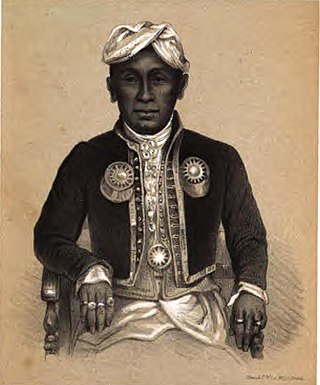Top Qs
Timeline
Chat
Perspective
Hidayatullah II of Banjar
Seri Sultan From Wikipedia, the free encyclopedia
Remove ads
Hidayatullah II (1822 – 24 November 1904) was the Sultan of Banjar who ruled between 1859 and 1862 and the main figure who led the opposition faction in the Banjarmasin War, a conflict between the Sultanate of Banjar and the Dutch East Indies which began with a struggle for the throne of the sultanate.[2][4]
Born as the son of Crown Prince Abdur Rahman, Gusti Andarun was the prime candidate for heir to the throne of the Banjar Sultanate to succeed his grandfather, Adam of Banjar. However, the position was instead filled by his half-brother Tamjidullah II who received support from the Dutch East Indies government.[5] This incident caused conflict within the sultanate family, where there was a camp supporting Tamjidullah who was close to the Dutch and a camp supporting Gusti Andarun who did not agree with the decision of the Dutch East Indies government.[2] To reduce the tension, in 1856 the Dutch East Indies government appointed Gusti Andarun as mangkubhumi with the title Prince Hidayatullah.[6][7]
However, this could not ease the tension between the noble families, the people, and the Dutch East Indies government. This tension also became the trigger for the start of the Banjarmasin War, where on April 18, 1859, Banjar troops led by Prince Antasari attacked the Oranje Nassau Coal Mine in Pengaron (now the north-central part of Banjar Regency).[8][9] The colonial government then impeached Tamjidillah II and tried to crown Hidayatullah as sultan, but Hidayatullah refused the offer. He himself was crowned by the Banjar commanders as sultan in September 1859.[10][11]
He led the Banjar War until 1862, when he and his family were captured by the Dutch East Indies.[12] Sultan Hidayatullah II and his family and some of his followers were then exiled to Cianjur, where he spent the rest of his life until his death in 1904.[13] For his anti-imperialist stance and his leadership in fighting the Dutch East Indies government in the Banjar War, in 1999 the government of the Republic of Indonesia awarded him the Bintang Mahaputera Utama.[14][15][16][17]
Remove ads
Personal life
Summarize
Perspective
Pangeran Hidayatullah was born in 1822 in Martapura. His father was Sultan Muda Abdurrahman son of Sultan Adam Al-Watsiq Billah, and his mother was Ratu Siti binti Pangeran Mangku Bumi Nata bin Sultan Sulaiman.
In 1852 the Sultan's heir-apparent died, and the Dutch replaced him by the illegitimate grandson Tamjied Illah. In vain, Sultan Adam and many nobles in 1853 sent an embassy to Batavia, pointing out iniquities perpetrated by the Dutch-designated heir and appealing for the Dutch to recognise instead Hidayatullah - a younger but legitimate son. Sultan Adam died in 1857 and was succeeded by Tamjied Illah. There ensued a struggle for power between Tamjied Illah and Hidayatullah, which divided the population, much of which stood behind Hidayatullah and highly resented the Dutch sponsoring of Tamjied Illah.[18] In early 1859, a revolt against Tamjied's rule broke out and the Royal Netherlands East Indies Army intervened on his behalf, but in June 1859 Tamjied stepped down. Unable to find a suitable successor, the Dutch colonial government decided to annex the Sultanate of Banjar in June 1860. In early 1862, Hidayat surrendered to Dutch commander Verspijck in exchange for permission to settle on the island of Java. The last rebels surrendered in 1863.
Hidayat died in Cianjur, Jawa Barat, 24 November 1904.[7]
Remove ads
References
Sources
Wikiwand - on
Seamless Wikipedia browsing. On steroids.
Remove ads

